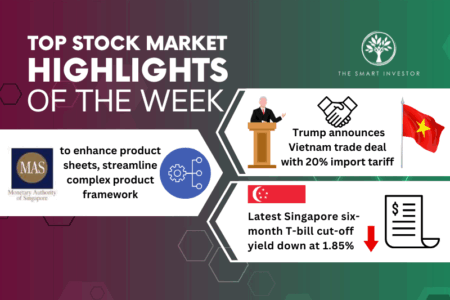OCBC Ltd (SGX: O39) is the last of the three Singapore banks to release its fiscal 2022 third quarter (3Q2022) earnings.
Last Friday, United Overseas Bank Ltd (SGX: U11), or UOB, released a sparkling set of earnings and reported a record S$1.4 billion net profit.
And yesterday, its larger peer DBS Group (SGX: D05) reported its highest net profit in history of S$5.8 billion for the first nine months of 2022 (9M2022).
Singapore’s second-largest bank did not disappoint.
OCBC reported a record net profit of S$1.6 billion for 3Q2022 along with an annualised return on equity of 12.4%.
Here are five highlights that investors should know about the lender’s latest earnings report card.
1. A surge in total income and net profit
For 3Q2022, net interest income (NII) surged by 44% year on year to S$2.1 billion, lifted by the strong rise in interest rates.
It was also the first time that OCBC had recorded a quarterly NII exceeding S$2 billion.
Non-interest income, however, dipped by 4% year on year to S$1.05 billion due to a 20% year on year fall in fees and commissions.
On the bright side, trading income more than doubled year on year to S$194 million for 3Q2022 while profit from its life insurance arm, Great Eastern Holding Limited (SGX: G07) rose 21% year on year to S$318 million.
Taken together, total income rose 23% from a year ago while operating profit before allowances climbed by 36% year on year to S$2.1 billion.
With allowances kept in check, net profit for the lender jumped 31% year on year to S$1.6 billion.
For the first nine months of 2022 (9M2022), OCBC reported a 14% year on year increase in net profit to S$4.4 billion, chalking up yet another record for the lender.
2. Subdued fee income
While NII has hit record levels, the same cannot be said for OCBC’s fee income.
The volatile investment climate has resulted in subdued customer activity, translating into weaker fees from brokerage, fund management, and wealth management.
Wealth management fees plunged by 40% year on year to S$179 million while brokerage and fund management fees fell by 22.4% year on year to S$45 million.
Wealth management assets under management (AUM) slipped slightly by 1% year on year to S$250 billion.
The decline was offset by year on year increases in other fee segments such as credit card, and loans plus trade-related fees.
3. Healthy loan growth
Customer loans grew 6% year on year from S$285 billion to S$303 billion, driven by countries such as Singapore, Indonesia, China, the US, Australia and the UK.
Sector-wise, the increase can be attributed to higher lending to the building and construction industry, financial institutions, and consumer companies.
Green and sustainable financing, an increasingly popular mode of borrowing, surged by 45% year on year and made up 9% of OCBC’s loan book as of 30 September 2022.
The bank’s onshore China corporate real estate loans made up less than 1% of its loan book, thereby mitigating the risks of a collapse in the property market there.
4. A surge in NIM
Similar to both DBS and UOB, OCBC also saw a sharp increase in its net interest margin (NIM) for 3Q2022.
NIM surpassed 2% for the quarter, clocking in at 2.06%, up 0.54 percentage points from the 1.52% registered in 3Q2021.
It was also 0.35 percentage points higher than the 1.71% reported in 2Q2022.
For 9M2022, NIM stood at 1.78%, higher than 1.55% in 9M2021.
The combination of higher NIM and the increase in OCBC’s loan book contributed to the surge in NII.
Looking ahead, the fourth quarter NIM is expected to exceed 2.1%, bringing further upside to the bank’s NII.
5. A cautious outlook
Despite the record results, Group CEO Helen Wong sounded a cautious note on the bank’s outlook.
Global economic growth is projected to become challenging.
She believes, however, that OCBC is well-positioned to capture opportunities due to its strong balance sheet.
For 2022, the bank is forecasting mid-single-digit year on year loan growth but remains mindful that inflation and political risks could further dampen global growth.
The lender is also working on expanding its digital and technology capabilities to serve its customers and is targeting to achieve net zero by 2050 as part of its ESG commitment.
In our special FREE report, Top 9 Dividend Stocks for 2022 – and 3 Tactical Shifts to Maximise Your Profits, we’re revealing 3 special categories of stocks that are poised to deliver maximum growth in 2022 and beyond.
Our safe-harbour stocks are a set of blue-chip companies that have been able to hold their own and deliver steady dividends. Growth accelerators stocks are enterprising businesses poised to continue their growth. And finally, the pandemic surprises are the unexpected winners of the pandemic.
Download for free to find out which are our safe-harbour stocks, growth accelerators, and pandemic winners! CLICK HERE to find out now!
Follow us on Facebook and Telegram for the latest investing news and analyses!
Disclaimer: Royston Yang owns shares of DBS Group.





